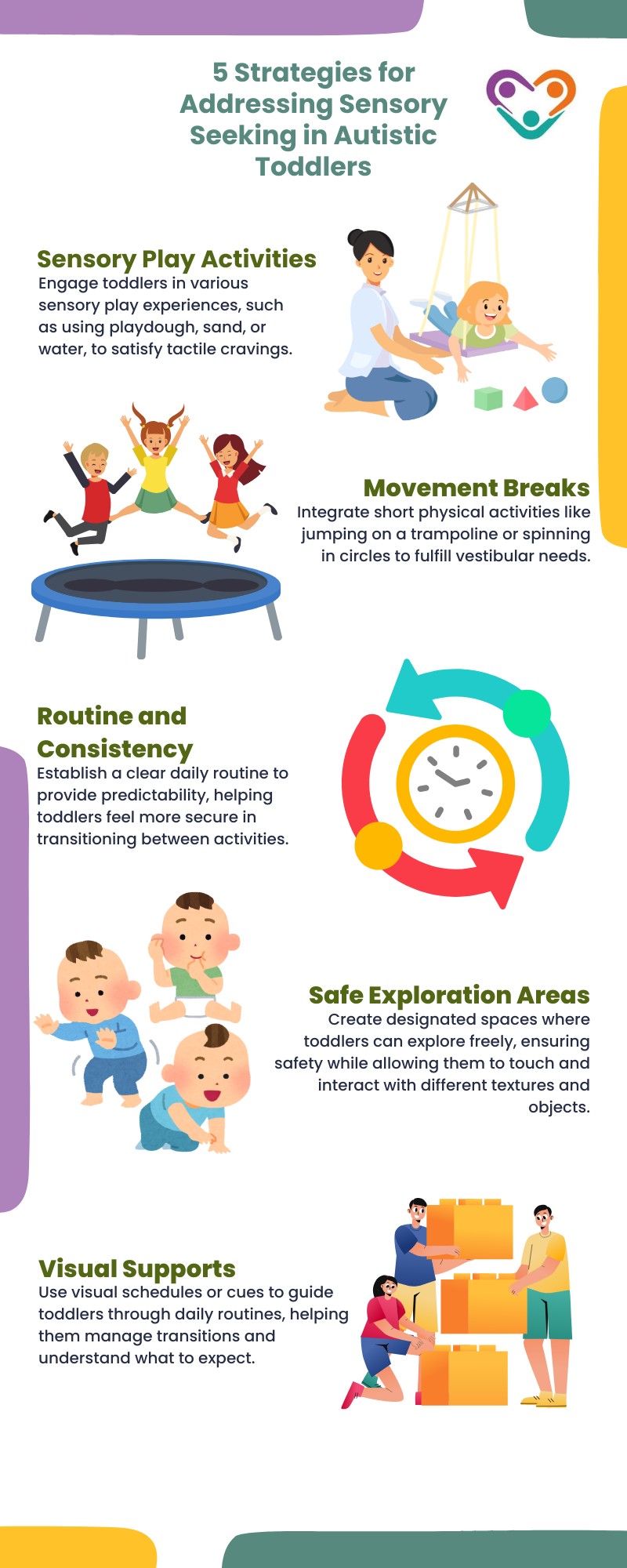Children with autism often engage in sensory seeking behaviors, which are actions taken to fulfill sensory needs and experiences. These behaviors frequently arise during free play activities and when children initiate stimuli during various home activities. Sensory seekers are often driven by the desire to engage multiple senses, demonstrating a multi-sensory nature in their behaviors.
Some common sensory seeking behaviors include:
- Jumping or bouncing
- Spinning or twirling
- Rocking back and forth
- Touching textures or objects repetitively
- Making loud noises or vocalizations
These behaviors help children explore their environment and satisfy their sensory cravings. However, they may also lead to challenges in social, educational, and home settings.
6 Types of Sensory Seeking
Sensory seeking can be categorized into various types based on the sensory modalities involved. Here are several common types:
- Vestibular Seeking: Involves movement experiences such as jumping, swinging, or spinning. These seekers may have difficulties with transitions, staying still in class, moving safely, or performing daily tasks.
- Tactile Seeking: Entails a desire to touch different textures or engage with sensory materials, such as sand or water, to explore how they feel.
- Auditory Seeking: Involves seeking out sounds or creating noise, such as humming or banging objects, to stimulate auditory senses.
- Visual Seeking: Includes behaviors that involve visual stimulation, like staring at bright lights or moving objects in an exaggerated manner.
- Olfactory Seeking: Focuses on exploring smells through sniffing or smelling various items in the environment.
- Gustatory Seeking: Pertains to a keen interest in different tastes and substances, sometimes resulting in the consumption of inedible items.
Understanding these types furthers insight into the sensory needs of children with autism. Through awareness and support, caregivers can help manage sensory seeking behaviors effectively, promoting better daily functioning.
Effects of Sensory Seeking
Sensory seeking behaviors can significantly impact everyday life. Such behaviors may interfere with tasks and routines if not managed properly. Children who primarily seek sensory input from the vestibular system may struggle with transitions, sitting still in class, or performing daily tasks like mealtime routines.
This can lead to challenges that affect their learning and social interactions.
Challenges are similarly faced by those who seek information from the other sensory systems, including proprioceptive, visual, auditory, tactile, gustatory, olfactory, and interoceptive inputs.
These difficulties can continue into teenage and adult years, necessitating continuous strategies to meet sensory needs across various life stages.
By understanding the eight sensory systems and the corresponding effects of sensory seeking behaviors, parents and caregivers can develop effective interventions tailored to the individual needs of children with autism.
Strategies for Management
Addressing sensory seeking behaviors in autistic kids requires tailored strategies that fit their age and developmental stage. Let’s look at some effective management techniques for toddlers as well as coping methods for teenagers and adults.
Strategies for Toddlers
Toddlers exhibiting sensory seeking behaviors may benefit from structured environments and activities that satisfy their need for sensory input. Strategies include:

Strategies for Teenagers and Adults
For older individuals, coping techniques must evolve to support their changing needs and help them manage sensory seeking behaviors effectively. Key techniques include:
- Mindfulness and Relaxation: Encourage practices such as mindfulness, deep breathing, or yoga to help individuals ground themselves and regulate sensory input.
- Sensory Diet: Develop a personalized sensory diet that incorporates regular activities tailored to meet one’s sensory needs throughout the day.
- Identify Strengths and Interests: Assist individuals in exploring their interests and strengths to promote self-confidence and provide positive outlets for sensory seeking.
- Use of Noise-Canceling Devices: Suggest wearing noise-canceling headphones or earplugs in overstimulating environments to reduce auditory sensory overload.
- Sensory-Friendly Spaces: Encourage the creation of personal sensory-friendly spaces at home or in workplaces where individuals can retreat when feeling overwhelmed.
Implementing these tailored strategies for toddlers and coping techniques for teenagers and adults can help manage sensory seeking in autistic kids effectively, leading to more positive and productive daily experiences. For a deeper look at how a supportive learning environment can further enhance these outcomes, explore our article “How Home Education Helps Autistic Children Thrive.“

The Key Takeaway
Sensory seeking is a natural and important part of many autistic children’s lives, helping them make sense of the world around them. While these behaviors can present challenges, especially in daily routines and social settings, understanding the different types of sensory seeking and how they affect individuals is the first step toward meaningful support.
With age-appropriate strategies, families and caregivers can create environments that honor sensory needs and promote growth, comfort, and confidence at every stage of life. At Golden Care Therapy, we offer high-quality ABA therapy through a compassionate, personalized approach that makes a real difference. Our team proudly provides autism services in Georgia, New Jersey, Indiana, New York, and Florida to help children thrive with evidence-based care tailored to their unique strengths and challenges. We believe every child deserves the chance to reach their full potential, and we’re here to support you every step of the way. Contact us today to learn how we can help your family get started.
Sources:



